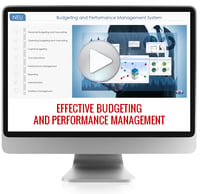It is a common mistake to assume that automation alone will bring necessary budget process improvements to an organization. Automating an inefficient or unintelligent budget process just makes the same process faster, not better.
The reality is traditional practices that govern budgeting, planning, forecasting, reporting, and risk management are becoming obsolete in the context of a fast-paced digital marketplace and a volatile and uncertain global economy. Long-established budget practices provide a false sense of security and fail to cope with the speed and volatility of today’s markets.
Additionally, the traditional budgeting process is widely decried, both by FP&A personnel—who must reconcile the requests from business managers with the targets handed down from the C-suite—and the business line managers they support—who view the budget process as a bureaucratic exercise, a distraction from their job, a drag on their time, and a purely finance-driven process.
As you consider a new budget system, remember this is the optimal time to evaluate the strategies that can help your organization develop a more agile and intelligent budget process, use this process as a decision-making tool rather than a negotiation, and positively change your organization’s perception of budgeting.
The following are a few strategies and best practices to consider:
Improve visibility into your performance.
Unfortunately, traditional line-item budgeting does not adequately link financial investments to results or outcomes, limiting the ability for in-depth analysis and understanding of the real ROI for any given line of business or initiative. Organizations should consider implementing a performance-based framework that allocates resources to specific objectives or activities based on appropriate metrics; ultimately, this framework provides increased visibility into how financial decisions translate into results. Keep in mind that only SMART (Specific, Measurable, Attainable, Realistic, and Timely) metrics should be chosen when implementing this framework.
De-stress your budget process.
Traditional budgets are created based on requests from competing stakeholders, each justifying their projected expenditures based on their departmental needs rather than the organization's overall goals. This method ultimately breaks down, resulting in an extended arbitrary decision-making process that cannot be objectively supported or justified. In other words, when the “best player wins” approach is taken, everyone loses. A performance-based evaluation framework helps establish concrete targets and priorities based on this year’s strategic goals and communicate those targets to all stakeholders involved in the budget process. By establishing a firm evaluation framework for all stakeholders to use, the organization will be able to make faster decisions and minimize budget negotiation issues arising from competing interests and priorities.
Add non-financial measures to your budget tracking processes to increase understanding of the real business drivers.
While periodic analysis of budget to actuals can provide insight into your budget’s current state, it is only a piece of the puzzle. Other indicators, such as key performance and operational measures, as well as outside factors, such as economic and market conditions, should always be considered. Delays in reporting (due to various reasons: books are not yet closed, measures not yet not collected, etc.) should be eliminated to ensure decision-makers have access to real-time information.
Update your budgets regularly to reflect reality.
Static budgets and multi-year financial plans produce high-level financial targets and constraints but not the roadmap to success. However, typically, once budgets are adopted, no further changes are allowed. If material deviations occur during the year, it can paralyze a company that does not have an efficient process for evaluating the causes of these changes and adjusting the budgets and plans accordingly. To be successful, budgets and plans should be updated as frequently as needed to reflect economic, organizational, and other outside variables rather than seen as ‘set in stone.’
Budget the way you run your business, not just the way you account for it.
Budgets are typically developed using the same account structure as the general ledger (accounting structure), as that is the level against which they are generally tracked; however, this view does a poor job of representing how the business is actually run. In reality, there are two additional structures that a budget must contain: the structure that identifies the major strategies and priorities that the organization is planning to execute (planning structure), and the structure that describes how the business will change under different scenarios (reporting structure). Organizations are often unable to easily develop and effectively manage budgets without using these three fundamental sets of structures.
Consider a driver-based approach.
Although the traditional budgeting approach has consistently shown high rates of inaccurate assumptions, a massive time commitment, and tedious manual input, adopting more sophisticated budgeting models and practices has been elusive for many organizations.
Driver-based planning, on the other hand, bases budgets and financial forecasts on operational drivers such as units of product, FTEs, customers, deliveries, transactions, etc. It uses mathematical and linked relationships to create detailed budgeting, forecasting, and planning models with fewer inputs than traditional models, while simultaneously reducing errors and saving time by using preset calculations based on operational activities. Note: This driver-based approach depends on the quality and availability of data, so the same SMART principles apply.
Remove excessive detail. Match the level of detail with your predictive capabilities.
Detail does not always equal accuracy - too little or too much can both have negative impacts on the budget process. For instance, too much detail can cause an overload of information, slow down the process, and cause more technical errors. On the opposite side of the spectrum, a lack of detail while budgeting for large-cost items or the most volatile revenue components may lead to miscalculations and material errors. The best practice is to focus on detail where it matters, and to plan in more detail for the short-term and less detail further out unless your predictive capabilities are proven, and your budget assumptions are not subject to volatility.
Expect the unexpected. Sacrifice detail for ‘what-if scenarios’.
In an unstable and sometimes volatile marketplace, drastic changes in resource levels, budget constraints, and strategies are inevitable. A flexible budget that considers performance under alternative (what-if) scenarios will serve your organization better than one that ignores the future and risks and invests too much time detailing the budget based on what happened in the past.
Shorten your budget cycle.
According to the 2008 Ventana Research benchmark study, “Planning and Budgeting: Improving Effectiveness through Best Practices and Technology,” budgeting and planning typically “eats up 10 to 15 percent of the finance organization’s time, and it takes five to eight months to complete the full cycle in large organizations.” While the length of time a budget should take varies by the size and complexity of an organization, the general rule of thumb is that your budget should take no more than 30 days to prepare. Otherwise, your budget will be outdated and irrelevant to current conditions before it has even been released. Technology can help streamline and speed up the process.
Improve your process through automation, and supercharge it with analytics.
Introducing analytics technology to the budget process can vastly improve an organization's budgeting, forecasting, and performance management capabilities. Not only can analytics speed up the decision-making process by making your data more accessible, but it can also highlight trends and exceptions, foster a common understanding of the various drivers of performance and their relationship to future outcomes, and help develop new insights based on the extensive use of data, statistical and quantitative analysis and predictive modeling.

This 15-minute video provides a brief overview of Neubrain's budgeting and performance management system, which can help an organization streamline and automate budgeting processes.

Admin
DEVELOPED BY NEUBRAIN EXPERTS, OUR BROCHURES, GUIDES, AND WHITE PAPERS ARE PACKED WITH BEST PRACTICES AND LESSONS LEARNED
RECENT POSTS

Transforming Public Sector...

How to Incorporate an AI Bot into...

How Government Organizations Can...
Signup Today For Our Blog


